All The Popular Ways To Pop Popcorn, Ranked
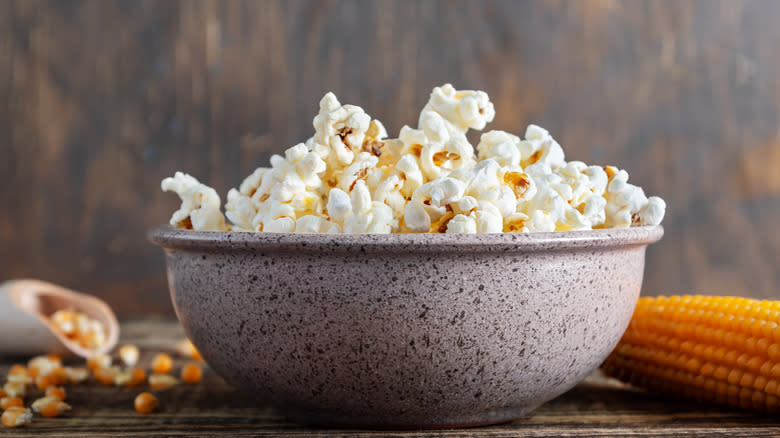
For being nothing more than a mostly dried grain that explodes when heated, popcorn sure has plenty of methods for achieving the perfect blast. It seems like as long as you apply the right amount of heat for the right amount of time, you can create a bowl full of fluffy kernels good enough to gobble by the handful. Even if making your own popcorn isn't your favorite culinary task, kernels crafted by professional poppers have their own specialized ways of breaking out of the bag.
As popcorn is an age-old plant-based delight, the methods meant for making this beloved snack have advanced by leaps and bounds. Home popcorn techniques in particular have seen explosive growth through the centuries, usually moving in lockstep with developments in kitchen gadgetry and the improvement of cooking appliances in general. We dug through the myriad means of making this magnificent snack and found a full-fledged feast of popping process, each with its own quirks and qualifiers, and arranged them to separate the prime poppers from the duds. Though all methods will result in a bowl you might enjoy, some are more beneficial for health and convenience -- popcorn's two tastiest considerations.
Read more: 7 Nuts You Should Be Eating And 7 You Shouldn't
Packaged Microwave Popcorn
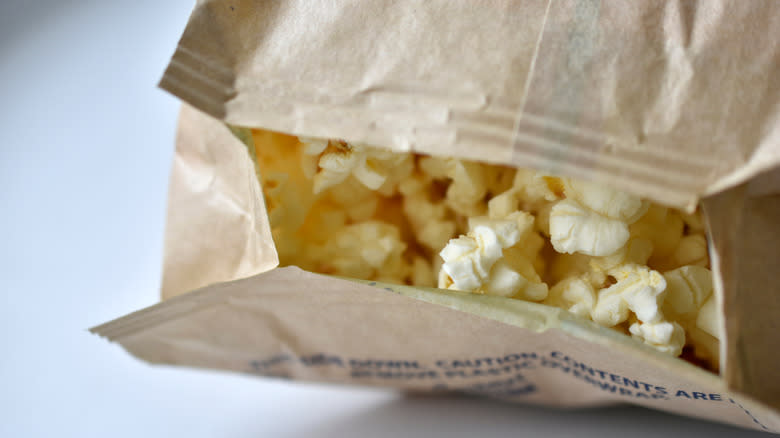
Prepackaged microwave popcorn is the most convenient popping around. You can simply rip into the cellophane, unfold the origami bag inside, and set your microwave for a swift three to four minutes to achieve a perfect pop. Every oven has its own power levels, so tinkering until you find the sweet spot is a must. But once you know the magic formula, you can do the math in your head and gear up for an at-home movie night while enjoying one of the closest flavors to authentic cinema popcorn available at grocery stores.
Though ease of use makes this modern method seem ideal, at first, the truth of microwave popcorn is it includes plenty of drawbacks. These bags are easy to overcook, resulting in burnt popcorn with an odor that doesn't depart easily. More than that, the numerous nutritional red flags such as high fat content and questionable ingredients like butter-flavored diacetyl and environmentally destructive palm oil make opting for packaged microwave popcorn as an unsavory default method.
Theater Popper
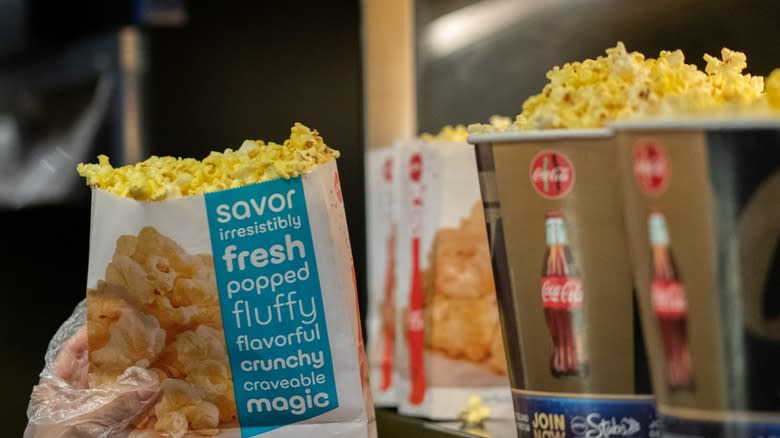
Few scents transport you to another time and place like the essence of theater popcorn. Without the aroma wafting through the space, it might almost not be worth paying $20 for a ticket to a movie that's destined for streaming in six weeks' time. Theater-popped popcorn sets the ultimate standard for fine flavor while bestowing upon cinema guests the convenience of having somebody else make the popcorn in a predetermined process, ensuring a delicious experience every time. Do you pay exorbitant prices to enjoy this experience? You bet your butter topping you do. But if an excursion to the land of movie make-believe is a form of escape, then popcorn is the indigenous food of the region. To step into a cinema without a bag or bucket is practically sacrilege, especially if the movie is a bomb.
However, the abominable nutrition facts about theater popcorn make this phenomenally popular popping process a questionable consideration. One tub of theater popcorn can net more than 1,000 calories and 49 grams of fat. With refills, you're looking at more than a day's worth of caloric intake in a single snack. This puts theater-popped popcorn near the very bottom of the bowl.
Countertop Popper
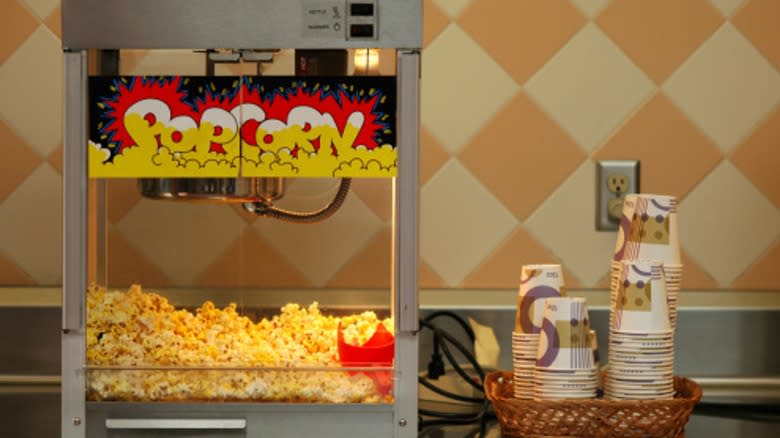
The undeniable charm of a countertop popcorn popper with an antique aesthetic has led many a popcorn fan to fire up their Amazon account and order themselves one of these vintage beauties. The aroma of oil-popped popcorn coming from this throwback contraption is enough to send the tongues and hearts of snack lovers into a tizzy. And the little paper bags and metal scoop included in the package make you feel like an old-timey vendor shilling snacks at a carnival. It's enough to make Orville Redenbacher's bowtie spin.
As with most contraptions from bygone eras, there are some definite cons to go with the pros of a countertop popper. The single-use paper bags create unnecessary waste, though it's easy enough to forgo using them in favor of snack bowls. The bigger issue lies in needing oil to make the kernels go "bang!" Anyone looking to control their fat and calorie intake will be at a loss while enjoying their toasty tasties. So, while a countertop popper is an undeniably attractive attention-getter for your at-home theater or cinematic rumpus room, it's more pretty than purposeful for proper popping.
Jiffy Pop
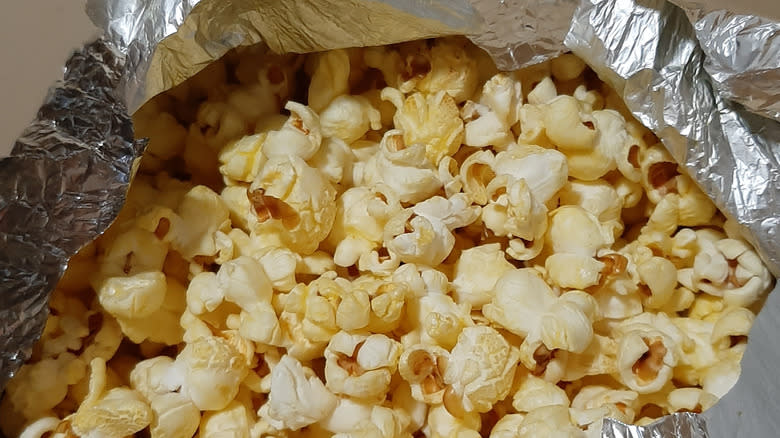
For some folks, Jiffy Pop evokes exciting childhood memories of watching the flat foil pan spring to life as soon as the heat hit the kernels inside. The excitement of watching your snack being created and knowing just how far along it was in the process was enough to make you feel like a mad scientist. Tearing into the taut foil without burning your fingers was tricky, but you weren't about to let a little thing like a steam burn cloud your victory. Some youngsters could burn their hands and their tongues on a nuclear-hot Jiffy Pop and smile the whole time. The magic was too much to resist.
The good news: Jiffy Pop still exists and can be readily found in most major grocery retailers and big-box stores around the U.S. The bad news: It isn't terribly cost effective. Walmart charges $2.18 for a 4.5-ounce ready-to-pop pan while also selling Pop Secret at $6.18 for 12 3-ounce bags, making classic Jiffy Pop a pricey yet nostalgic once-in-a-while popping process.
On The Cob
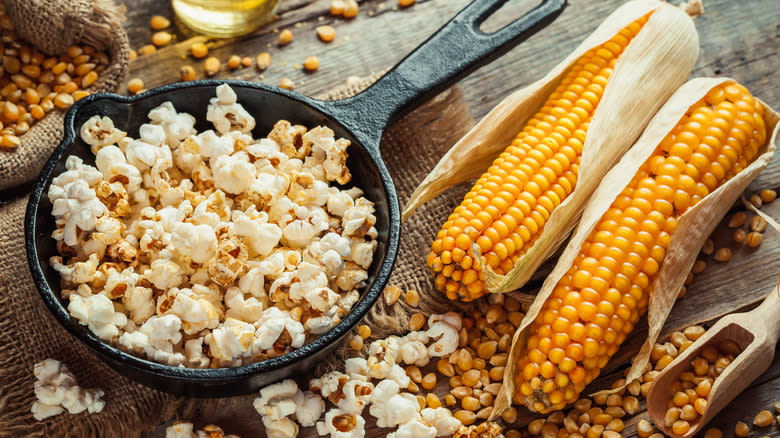
For anyone who doesn't know that popcorn can be made simply by placing a dried corn cob in the oven, here's the scoop: On-the-cob popping is one of the most fun popcorn-popping methods around and has been for thousands of years. This shouldn't be a surprise, considering that corn was a staple of the early Native American diet. Popping corn on the cob requires a brown paper bag to catch the kernels and a microwave oven set to your usual popcorn popping time -- usually between three and four minutes. When finished, you'll have a mostly empty cob and a bagged snack to season and enjoy.
A major consideration in this process is the availability of cobbed popcorn. While there are always bagged and jarred options on grocery store shelves, popcorn cobs are a specialty item. You can find them on Amazon, though they might be a bit pricier than the more abundant popcorn sources in your area. Think of this one as a fun sometimes treat to amaze onlookers on special corn-popping occasions.
Air Fryer
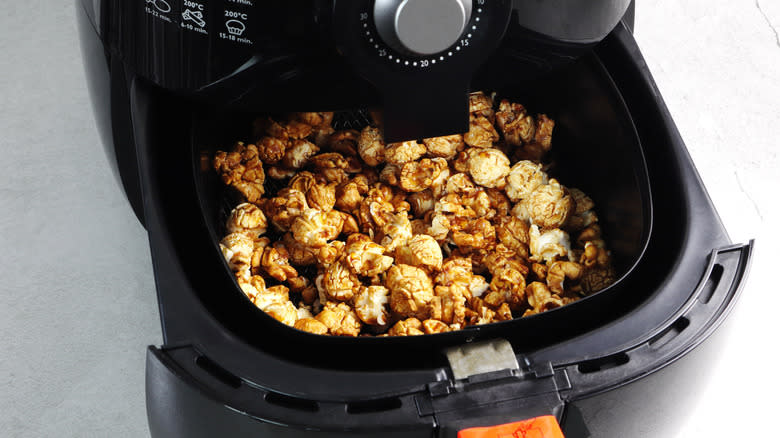
Add popcorn popping to the ever-expanding list of cooking tasks air fryers are equipped to tackle. Air fryer popcorn uses a bit of oil to get things heated up, but you can control the amount of oil for a more health-minded finished dish. Unlike many other methods, air frying your kernels lets you remove the popped pieces and replace the basket to allow the underheated kernels to finish up. You get a more complete pop this way without having to return to the popper after sifting through the edible portion of the bowl. This means your popcorn money goes further and you get more of your favorite nibble in the transaction.
The unbuttered truth about air fryer popping is that you have to have an air fryer in order for it to work. As popular as these cookers have become, they're still not a staple in every household. To purchase one solely for the purpose of popping popcorn means shelling out substantial cash when there are healthy, convenient methods that make use of tools you already have around the kitchen. But if you have an air fryer and popcorn is your thing, give it a shot and see what's poppin'.
Dome Popper
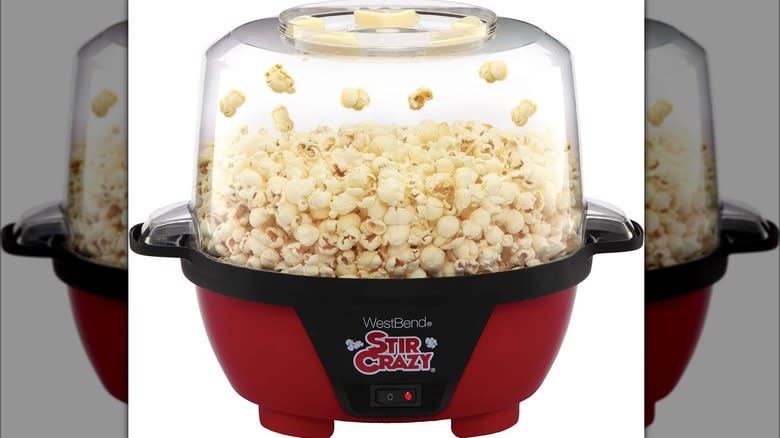
Ah, the 1970s, when kitchen convenience advanced at a space-age clip. With that convenience came the advent of the dome popcorn popper. This super-futuristic yet somehow incredibly dated-looking vessel invited you to add your kernels and oil to the heated base and watch the fireworks go off through the acrylic bowl on top. Within minutes, you had a bowl of popcorn in a mixing-bowl-sized catcher that could be turned upside-down to become a serving bowl. A small dish on top let you melt your butter topping while the popcorn popped. For a time, it seemed like this delicious little device had everything a popcorn lover could ever want.
Though dome poppers disappeared for quite a spell, the cry for vintage cookery brought the dome popper out of the realm of the thrift store and into the world of kitschy kitchen creations once again. These energetic electric cookers can create nearly 7 quarts of fresh, fabulous popcorn in four minutes. The one downfall of these perky poppers is their size, which requires a dedicated storage spot. As for the popping, the dome is home to one very hot snack-prep process to try.
Air Popper
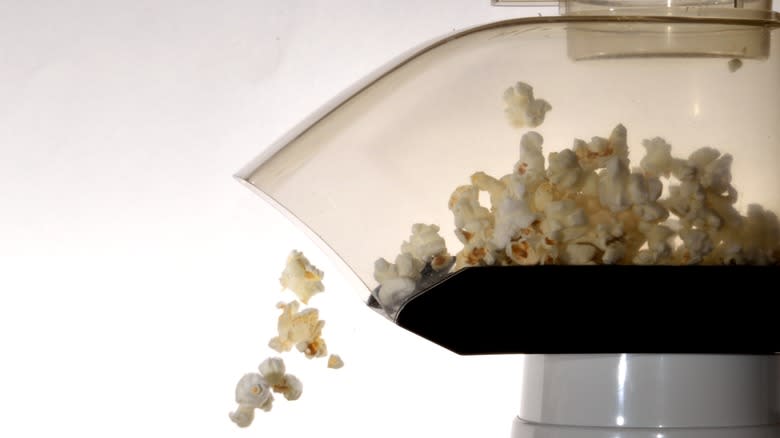
If you're into dedicated popcorn makers and your kitchen counter has room for another gadget, you might be a candidate for an air popper. These charming contraptions are like hair dryers with a compartment to hold your kernels. There's no oil or butter necessary to get the popping hopping, making for a very clean and customizable finished bowl. The ingenious design keeps popped kernels flowing out of the heating chamber to prevent burning, while solid unpopped kernels remain near the bottom. This clever one-two popcorn punch provides foolproof prep that's ready for as many rounds as you are.
The few drawbacks to this type of popper include the patter-and-scatter factor. The sound this little engine makes while making your snack can be a bit irritating -- akin to a low-flying airplane buzzing your granite countertops. Though it doesn't last more than a few minutes while the machine operates, it's a definite consideration for a process that usually reserves its sound effects for the blasting kernels. Some models are prone to spewing raw kernels, too, resulting in untidy prep with clean-up required. This hitch is balanced out against the fact that, due to their oil-free operation, air poppers remain relatively mess-free otherwise.
Oven Popping
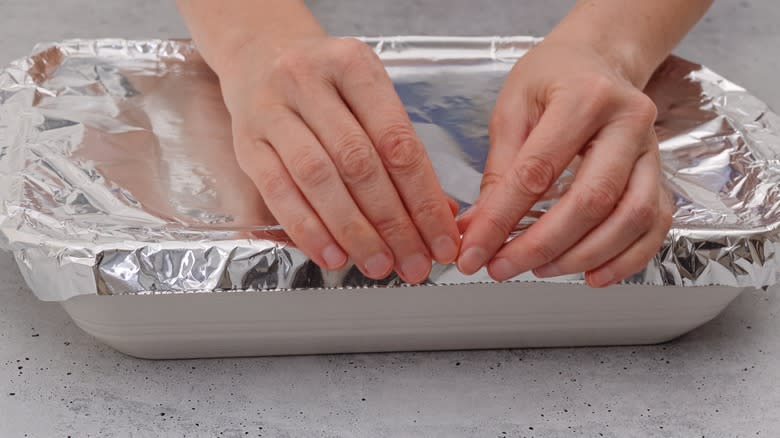
If stovetop popping seems a bit tedious, the brilliant variation of oven popping may be a workable alternative. It's a genius kitchen hack that lets you treat popcorn popping the same as roasting vegetables, only nobody cooks up a pan of carrots and cauliflower to snack on while catching up on "Stranger Things." All it takes is popcorn kernels, oil, a roasting pan or a 9x13 cake pan, and a length of aluminum foil long enough to cover the top. Drop a quarter cup of oil and a half cup of kernels into the pan, cover with foil, and slide it into an oven at 400-degrees Fahrenheit. You should hear popping for about a minute once the action starts. Remove the pan and give it a little shake-shake before peeling back the foil and enjoying your bounty.
Because the heat is applied so heavily in the oven method, it will take your undivided attention to make sure you don't scorch your corn. This isn't terribly different from other methods, but the possibility of popcorn mistakes increases due to the lack of visibility of your kernels. Try this one only if you're ready to put your chef skills to the test.
Kettle Corn
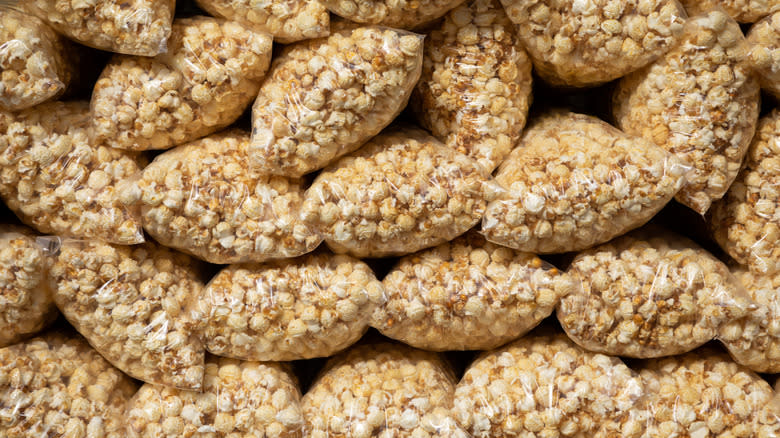
Half the fun of enjoying kettle corn is watching it get popped in the gigantic kettle by the kettle master. The other half is walking around with a bag that's almost as tall as you are. And the third half -- because popcorn math is tricky -- is diving in for handfuls of crispy popcorn that's alternately sweet, salty, and a bit caramelly. The sheer joy that comes from watching others grow hungry as you gorge yourself on this true treat is a popcorn situation like no other. Let them follow the sublime cent and get their own. Add the visual performance of seeing the kernels come to life in enormous batches, and you have a process that leaps up darn close to the top of our list.
But there are kettle considerations to think about. Though the call of kettle corn may be difficult to resist once you enter the grounds of a craft fair or fall festival, the added sugar in the recipe may be enough to give gregarious snackers cause for pause. There are home versions that let you alter your ingredients to suit your needs, which might be a preferable way to pop.
Brown Bag
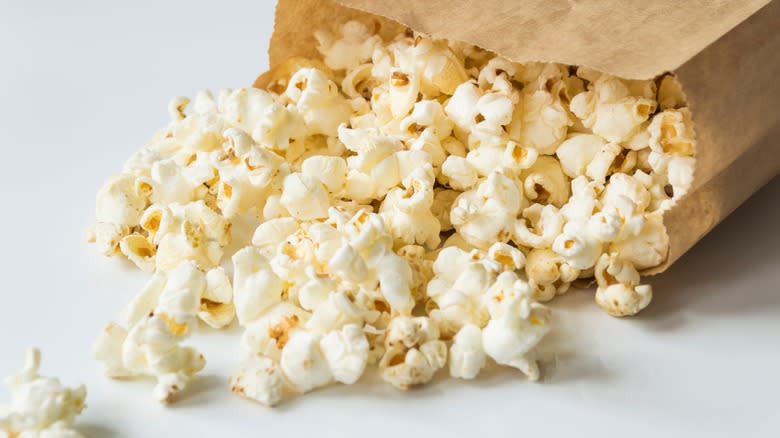
In the early days of microwave cuisine, popcorn people would drop kernels into a brown bag to let the microwave do the popping. It was safe and easy and everybody with a futuristic cooker could get their corn on whenever their movie night appetite made the call. It may sound a bit primitive considering the evolution of microwave popping. But this tricky little technique was our introduction to using a microwave to make a timeless snack, and it works just as well today as it did back then. Best of all, it produces light and fluffy popcorn in under two minutes -- no oil or butter necessary.
The drawbacks for brown bag popping lie in the availability of brown paper bags. There used to be a steady stock in every kitchen, ready for daily work and school lunch prep. But single-use paper goods are Earth-killing dinosaurs to modern humankind, and having one on hand for popcorn means buying a package of at least 50 when all you really need is one. But if you're game, it's a fun and healthy way to hop on the pop.
Stovetop
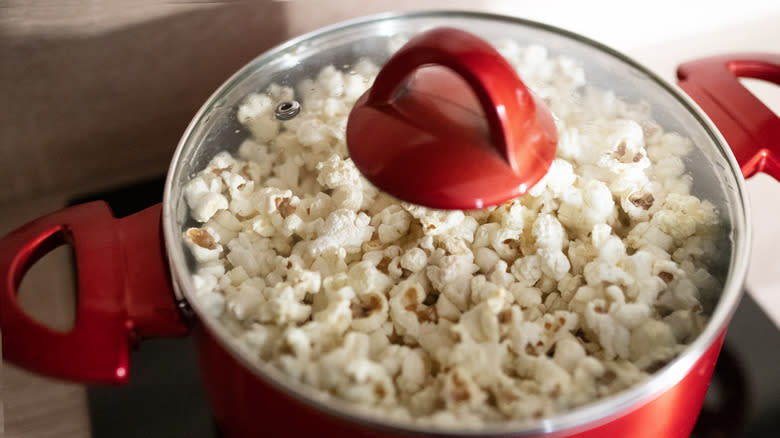
Stovetop popping is by far the best-known and best-remembered popcorn making method. For generations, kitchen conquerors have been standing at their range, sliding a Dutch oven or sauce-pan to-and-fro over the burner, hoping not to scorch the kernels before they become fluffy and fantastic. If you have a bit of oil, a jar of kernels and enough patience to watch the pot, you can make bowlfuls of magnificent popcorn, ready to be seasoned or sweetened however you like. It's the purest form of popcorn making and a fun link to the ancient ways of your ancestors from the 1950s.
But this process is also mighty touchy, making it impossible to take your eye off the price for even a second, lest you return a pot full of ashes and a house full of smoke. If you're patient enough to stick it out for the entire time, you'll be rewarded with a peppy pot of perfectly popped popcorn to share or to hoard depending on how you feel about your friends and loved ones. After all, you're the one who'll be putting in the labor and keeping an eagle eye over your precious percolating pieces. They're yours to do with as you choose.
Microwave Popper
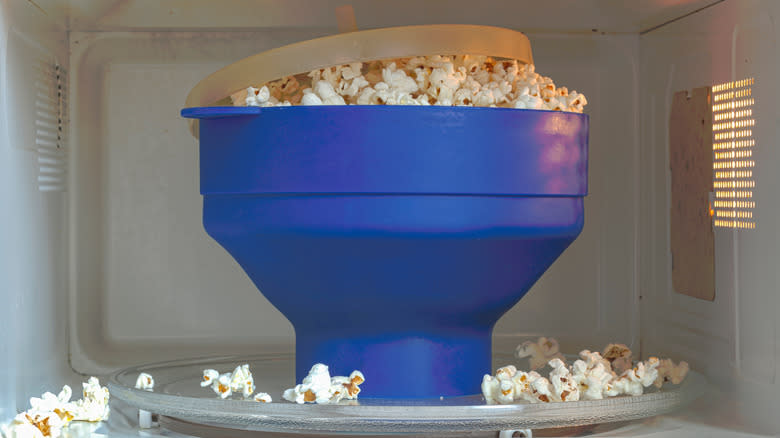
Having an affordable piece of microwave cookware dedicated to popcorn popping removes the risk of the ever-disappointing burnt bag -- a consequence that also results in a repulsive oven odor second only to microwaved fish. The fact that a collapsible silicone microwave popcorn popper also serves as a bowl to enjoy your finished product in is a tasty bonus that makes shelling out a few bucks a worthy investment. The customizable nature of this useful gizmo lets you create a bowl sized to your serving preference. Looking for a few fluffy handfuls? Shrink it down for fewer kernels. Hoping to serve a hungry family? Crank it open for 15 cups in four quick minutes. There's a nifty lid that makes scattered kernels an impossibility, keeping your snack in place and your oven clean. Oil and seasonings are optional, but even having them in the plans can't spoil the easy clean-up and fold-away storage the soft silicone design provides. It's also BPA and toxin-free, which are important health features in microwave cooking.
If there are any drawbacks to this slick trick of a popper, we can't find them, which is why we call this near-perfect method the top of the pops.
Read the original article on Mashed.

